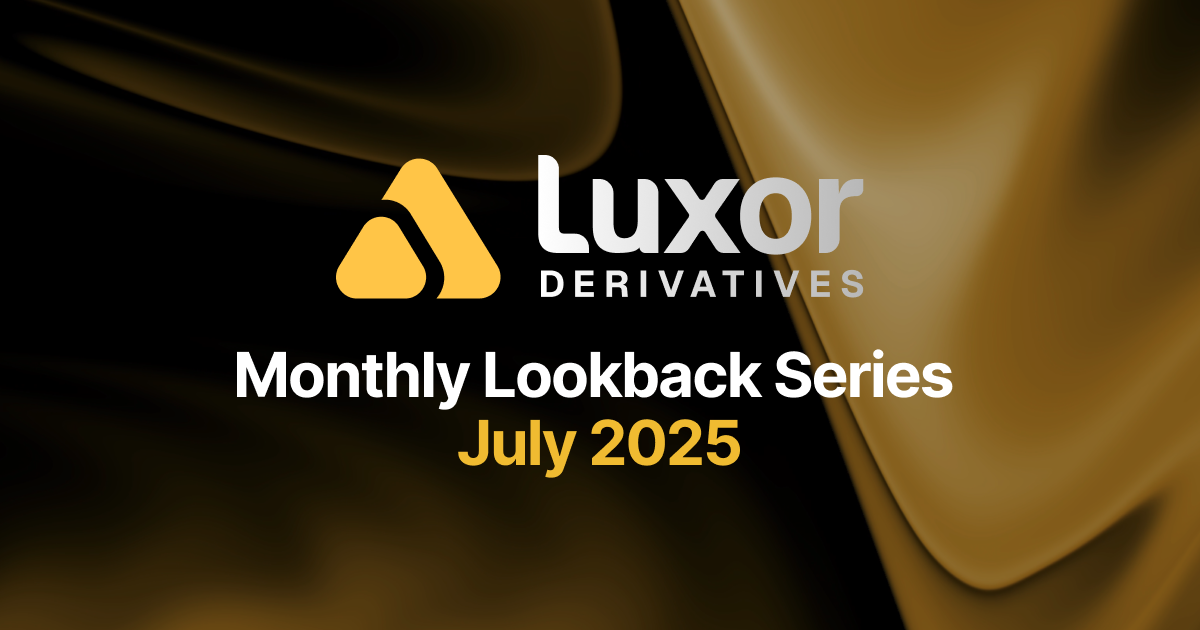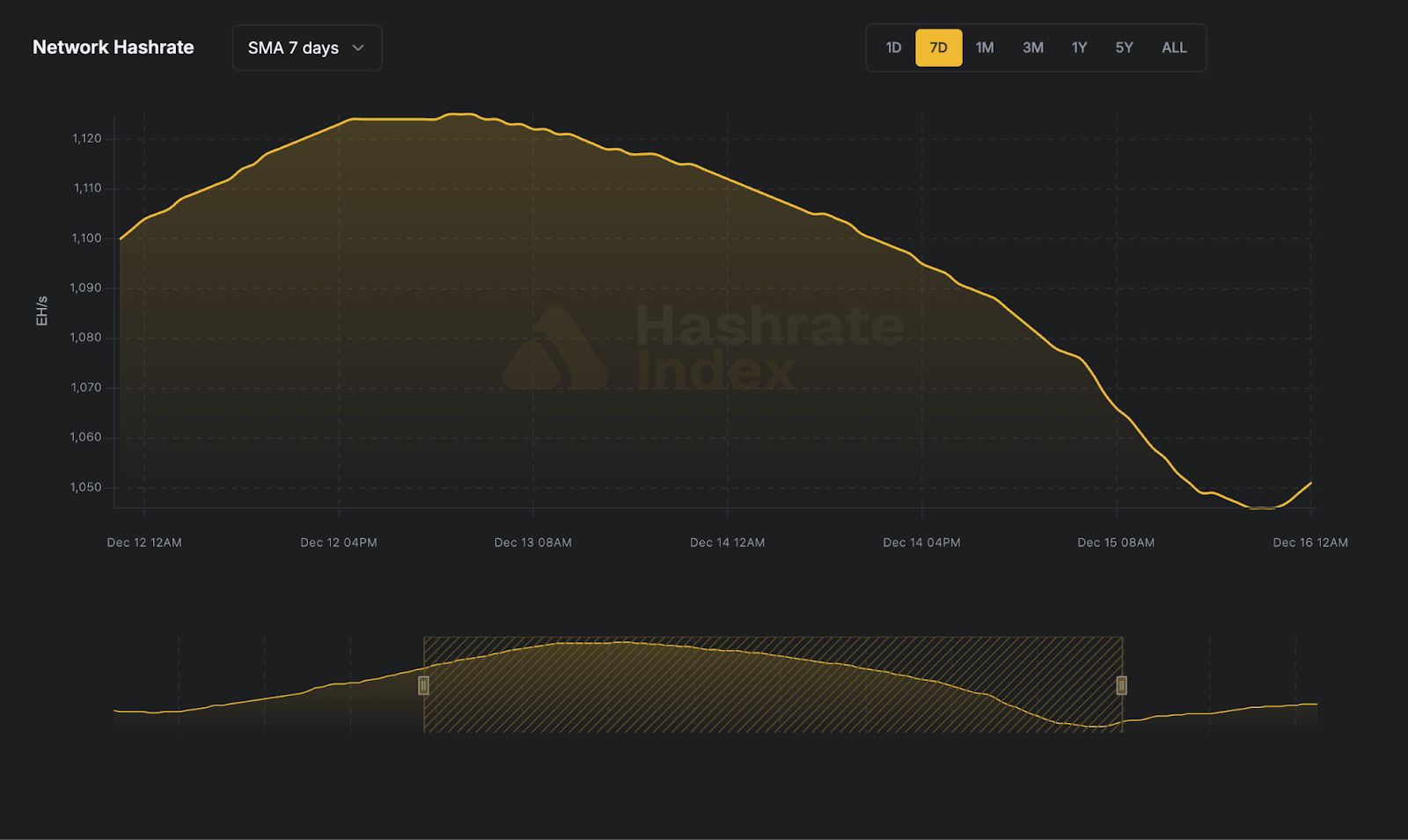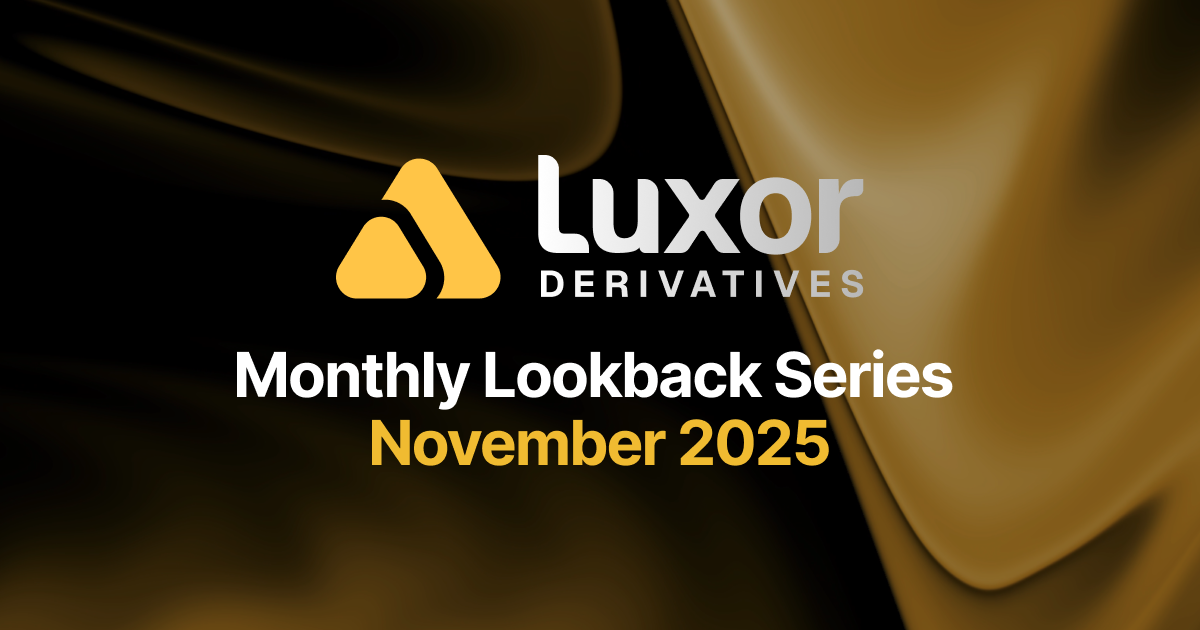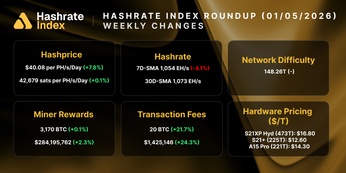
Luxor Hashrate Lookback Series - July 2025
July 2025’s hashrate and hashprice trends, forward market participation, trading activity and contract performance.
Luxor’s Monthly Lookback Series is a deep dive into Bitcoin hashrate market activity. In this post, we cover July 2025’s hashrate market and hashprice trends, forward market participation, trading activity and contract performance.
Summary
- Hashprice Heats Up: Following a sluggish June, USD-denominated hashprice rebounded +11.4% in July, driven by Bitcoin price action and a modest relief in network difficulty. This month’s average of $59.38 per PH/s/day was the highest fo sar in 2025.
- Bitcoin Breaks New Ground: BTC rallied in July (+8.9%), marking a new all-time high ~$120,786.
- Difficulty Climbs Higher: After June’s back-to-back downward adjustments, network difficulty reversed course with back-to-back increases, climbing up to a new all-time high of 127.62T. However, July 2025 marked the first decline (-2.3%) in monthly average network difficulty since July 2024, breaking a 12-month streak of consistent hashrate growth.
- Hashrate Hedging: BTC-denominated hedging continued to outperform spot FPPS mining, especially on longer time horizons.
July 2025 Spot Hashprice & Its Constituents
Following a slowdown in June, mining economics experienced a notable recovery in July. This was primarily fueled by Bitcoin price action (+8.9%), with additional relief from a modest decline (-2.3%) in monthly average network difficulty. On the other hand, transaction fees continued to trend down (-7.6%) to 0.031 BTC per block. Overall, USD-denominated hashprice averaged $59.38 per PH/s/day ( +11.4%), whereas BTC-denominated hashprice averaged 0.00052 BTC per PH/s/day (+2.4%).
USD-denominated hashprice started the month at $57.83 per PH/s/day and rallied to a local peak of $63.80 on July 11, before settling back to $58.66 by month-end. The intra-month surge coincided with Bitcoin's rally, followed by normalization throughout the second half. Overall, USD hashprice ranged between $57.83 – $63.80 and came out to a monthly average of $59.38, an 11.4% improvement month-over-month.
Bitcoin price action was the main driver of hashprice in July. Starting at $106,504, BTC rallied to a new all-time high of ~$120,786 on July 14, before gradually declining over the second half of the month to close off at $117,960. Overall, the monthly average BTC price came in at $115,184.
For the first time since last year, monthly average network difficulty declined (-2.3%) in July, breaking a 12-month streak of consistent ~3% monthly hashrate growth. Following June’s back-to-back downward adjustments, two positive adjustments on July 12 (+7.96% ) & July 25 (+1.07%) increased difficulty to 127.62T, a new all-time high. However, the monthly average difficulty experienced by operators came in at 123.15T versus June's 126.08T.
The positive adjustments were caused by quicker-than-average block time intervals in July. Just 4 out of 31 days (13%) for the month averaged block discovery times above the 10-minute target, compared to 12 out of 30 days (40%) in June.
Transaction fees continued their downtrend in July. A temporary spike (+123%) occurred on July 24 — driven by BRC-20 2.0 minting activity — however this was not enough to move the needle. On a BTC-denominated basis, miners collected an average of 0.031 BTC (per block per day), a 7.6% decline from June and the lowest since November 2011. This picture was a little less disappointing on a USD-denominated basis, with average fee collection coming out to $3,626 versus $3,588 in June, a mere 1.1% improvement.
Given a constant block subsidy and ever-drying fees, BTC-denominated hashprice reflected network difficulty adjustments in July. It began at 0.00054 BTC per PH/s/day and dipped to 0.00050 BTC following the two positive difficulty adjustments on July 12 & July 25. Overall, BTC hashprice averaged 0.00052 BTC per PH/s/day, declining 4.4% month-over-month.
Energy-adjusted mining revenues were particularly healthy for operators with newer-generation hardware in July. On a monthly average basis, operations with sub-19 J/TH fleets earned approximately $146 per MWh, whereas miners in the 19-25 J/TH and 25-38 J/TH efficiency tiers earned around $112 and $77 per MWh, respectively.
July 2025 Hashrate Market Activity
Our analysis of the July hashrate market focuses on two key points: how the July 2025 hashrate contract traded in previous months and how the forward curve shifted in July , based on pricing for forward hashrate during the month.
The two tables below show the evolution of USD and BTC denominated Bitcoin hashrate forward markets from January 2025 – July 2025. Rows represent specific monthly contracts, while columns represent each trading month. Cell values indicate the average monthly mid-market price — except for the bold highlighted main diagonal — which shows actual spot hashprice settlement in each month.
This table summarizes both the trading history of the July 2025 contract (colored row) and the forward curve in July (colored column).
Note: all values shown in figures represent the midpoint of the best bid and ask on Luxor's Non-Deliverable Hashprice Forward market.
The table below shows the type of market participants on the buy and sell side of Luxor’s deliverable (DF) and non-deliverable hashrate forward (NDF) market. In July lenders were active on the buy side of the DF market, while public and private miners used the contract to sell forward, receive financing, and expand their fleet.
Since the DF involves upfront payment, it tends to trade at a discount to the NDF (compensating the buyer for the inherent credit risk). We see the discount of DF’s relative to NDF’s as the interest rate in hashrate-based lending markets. Buyers and sellers of the DF with upfront payment can use the NDF to lock-in a fixed yield or cost of capital instead of having exposure to hashprice uncertainty.
This strategy was used by lenders (i.e., buy the DF & sell the NDF) to earn a return and by miners (i.e., sell the DF & buy the NDF) to obtain non-dilutive financing. In July 2025, that yield or cost of capital was in the 8-13% (annualized) range.
How July 2025 Hashrate Traded
In USD terms, the July 2025 contract was a clear win for buyers across the board. The best strategy for miners and traders was to buy USD-denominated hashrate, locking in a fixed hashcost throughout February – June. As the hashrate market rallied, participants who entered in March or April saw the highest gains, with July’s spot FPPS revenues reaching $59.38 per PH/s/day — well above their fixed hashcosts of $45.28 – $48.65 per PH/s/day.
On the BTC-settled side, sellers came out ahead over longer durations, but buyers won over shorter durations. Early forward sales (February – March) outperformed spot FPPS by 5-7%, while later hedges throughout April – June essentially broke even or saw a loss of ~3%, respectively. The best performance for BTC-denominated sellers was marked by a 4-month forward sale in March, which would have earned an additional 7% in BTC production by locking in fixed pool payouts at 0.00055 BTC per PH/s/day versus spot FPPS rates at 0.00050 BTC in July . Those who used upfront payouts even received immediate, non-dilutive capital in exchange for a fixed commitment to deliver hashrate over time.
The tables below summarize how a 1 EH mining operation would have performed by selling July 2025 hashrate forward — one showing USD revenue outcomes, the other showing total bitcoin production — compared to spot mining via FPPS.
Zooming out, the following chart reveals how different rolling hedge strategies performed relative to spot FPPS mining, segmented by contract denomination and hedge horizon over the past year, from June 2024 – July 2025:
This comparison clearly shows that rolling BTC-denominated hedging strategies outperformed between June 2024 and July 2025, with the strongest results coming from 5-month (+15%) and 4-month forward sales (+10)%. These longer-duration contracts were typically priced ahead of rising network difficulty and low fee environments, while still preserving Bitcoin price exposure. In contrast, USD-denominated hedging underperformed spot FPPS by an average of -2.0%.
Miners who locked in fixed payouts between July 2024 and July 2025 were better insulated from the hashprice decline driven by difficulty increases and weak fee activity. Those who used upfront payouts went a step further by front-loading revenue.
Note: these figures are strictly for demonstration purposes and exclude fees and bid/ask spreads associated with entering into hashrate forward contracts.
A second caveat: although selling forward proved to be favorable during timeframes shown above, it is critical to recognize that hedging is typically a cost of business rather than a revenue generation method. Hedgers willingly pay a price to buy certainty and obtain more predictable cash flows, which increases valuation, reduces cost of capital, and ultimately attracts investments.
How Future Hashrate Traded in July 2025
The two tables below summarize the evolution of hashrate forward markets during July 2025, for the subsequent five months from July 2025 – November 2025. Rows represent specific monthly hashrate contracts, while columns represent specific trading days. Cell values indicate the average daily mid-market price, except for spot prices.
Between July 7 and July 28, August 2025 to December 2025 USD-denominated hashrate forward contracts rose 9–10% as Bitcoin price strengthened and spot USD hashprice recovered. In comparison, BTC-settled contracts rose 0–2%, reflecting the BTC hashprice dip driven by weak transaction fees and all-time high network difficulty. Most monthly contracts traded in backwardation throughout the period, however the front-end July and August contracts showed a slight contango.
By dividing USD contract values with BTC contract values, we can use the two contracts to back out implied Bitcoin price expectations expressed by the forward market. Throughout July implied Bitcoin price expectations traded mostly in contango and rose 8–10%, mirroring price action in spot BTC markets and indicating near-term bullish sentiment.
If we make an assumption around transaction fees, we can also calculate the changes in implied difficulty and network hashrate expectations expressed by the forward market. In the tables below, we assume a 0.03 BTC per block transaction fee collection on July 7 and August 4, respectively:
Note: figures assume 0.030 BTC and 0.030 BTC per block transaction fee collection on July 7 and August 4, 2025.
Based on this simplified analysis, we estimate that future hashrate expectations remained steady during the month of June, rising in the 0-1% range for the August 2025 – January 2026 contracts.
Concluding Thoughts and Looking Ahead
July marked the second inning of ERCOT’s Four Coincidence Peaks (4CP) program, and the impact of this behavior has already been visible. Looking ahead, we anticipate relatively muted hashrate growth through August – September as miners in Texas navigate the summer period, with more robust growth expected to resume in October once seasonal demand response programs subside.
As Bitcoin miners become increasingly sophisticated power market participants, their ability to manage energy costs becomes a competitive edge. If you are interested in learning more about mining and energy, check out our recently launched series: Energy Markets for Bitcoin Miners.
In the first post of this series, we explored how Bitcoin miners manage market exposure through spot and fixed-price power contracts. These hedging profiles offer different trade-offs: spot provides flexibility, while fixed-price power introduces cost certainty and the potential to monetize volatility through grid resale.
In the second post, we dug into a more advanced strategy: fixed-price power contracts overlaid with financial instruments, specifically short call options on power and fixed Bitcoin mining pool payouts. Together, these tools allow miners to lock-in and grow stable operating margins.
In the third post, we analyzed how flexible miners earn revenue by supporting the grid — and why structure matters.
Looking forward, Luxor’s Hashrate Forward Market is pricing in an average hashprice of $54.80 or 0.00047 BTC per PH/s/day over the next six months. Sellers can currently secure this hashprice while buyers have the opportunity to lock in the same hashcost through to January 2026.
If you’d like to learn more about Luxor’s Bitcoin mining derivatives, please reach out to [email protected] or visit https://www.luxor.tech/derivatives.
Disclaimer
This content is for informational purposes only, you should not construe any such information or other material as legal, investment, financial, or other advice. Nothing contained in our content constitutes a solicitation, recommendation, endorsement, or offer by Luxor or any of Luxor’s employees to buy or sell any derivatives or other financial instruments in this or in any other jurisdiction in which such solicitation or offer would be unlawful under the derivatives laws of such jurisdiction.
There are risks associated with trading derivatives. Trading in derivatives involves risk of loss, loss of principal is possible.
Hashrate Index Newsletter
Join the newsletter to receive the latest updates in your inbox.








